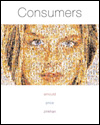This chapter has outlined some of the major aspects of how and what consumers
experience, learn, and know. There is much yet to discover, and many mysteries
about the interplay between experience, learning, and knowledge are yet to be
imagined. Emotions, culture, and context are fundamental to their fundamental
nature and the interplay among them. Consumer experiences, learning and knowledge
also contribute to meanings in ways this chapter has only touched on. In Chapter
Eighteen, we will delve in depth into the construction of meaning from experiences
and memories of experiences. Consumer experiences are at the heart of consumer behavior, and many industry
experts argue that economic value turns on offering memorable experiences, or
better, transformational experiences. We provided a typology of consumer experiences
and stressed that consumer experiences include anticipated consumption, purchase,
consumption, and remembered consumption. Marketers need to understand how anticipated
consumption relates to consumers aspirations and goals. In Chapter Seventeen,
we will describe post-consumption experiences, and in Chapter Eighteen we will
discuss further how consumption experiences create consumer meaning. Learning , memory and knowledge are closely linked. We provided a view
of consumer learning as adaptive and determined by value systems, desires, needs,
and what the learning already knows. We can think of consumers as generating
guesses or hypotheses about the way the world works, in order to make adaptive
choices that move them towards their goals. We provided a simplified model of
consumer learning based around consumer guesses and exposure to evidence. There
are lots of different ways to learn. We talked about learning from experience
and learning by description as two different ways. We briefly outlined two behavioral
learning theories--classical conditioning and operant conditioning. These two
approached have helped us discover useful techniques for stimulating learning.
Almost all consumer decisions include a memory component. Each time we
say or remember something we put it together from bits and pieces stores separately
in our brain. Memory is constructive and it is a culturally constructed, social
activity. Memory is not like a computer, but we can think of it as occurring
in three stages: input, storage, and output. Consumers have a variety of schemas
and scripts that help them organize experiences. Memories can be distinguished
in terms of short-term and long-term, and long-term memories can be further
categorized as semantic or episodic. Semantic memories are what we generally
think of as knowledge. One type of knowledge marketers are especially interested
in is brand knowledge. We included a description of the types of associations
consumers have about brands. We also summarized several different techniques
marketers can use to influence memory. Consumers are overwhelmed by information and choices. Memory related constraints
have a strong impact in judgement and decision-making. Although these constraints
may lead consumers to make less than optimal choices, they are also adaptive
and many times help consumers feel good, and attain their goals. We described
some common context effects, and some cognitive heuristics that consumers use
to collect and use information and knowledge. On the horizon, we see the development
of a variety of electronic agents or "knowbots" that will help consumers
gather, store, and output relevant information. |




 2002 McGraw-Hill Higher Education
2002 McGraw-Hill Higher Education


 2002 McGraw-Hill Higher Education
2002 McGraw-Hill Higher Education